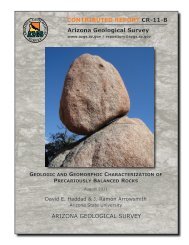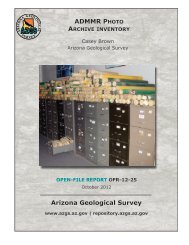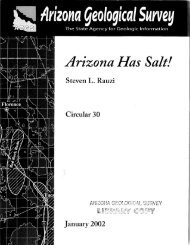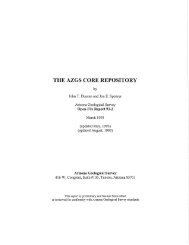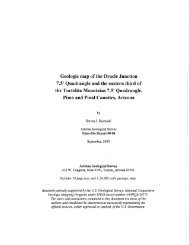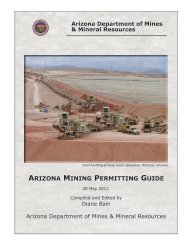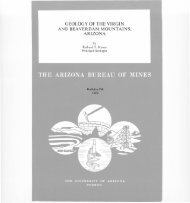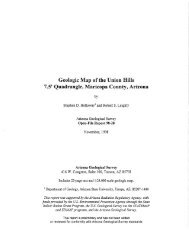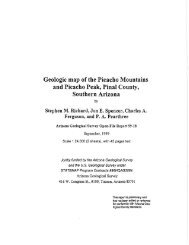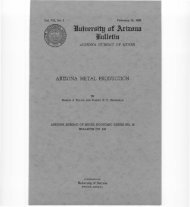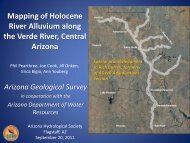Subsurface Geologic Investigation of Fountain Hills - AZGS ...
Subsurface Geologic Investigation of Fountain Hills - AZGS ...
Subsurface Geologic Investigation of Fountain Hills - AZGS ...
You also want an ePaper? Increase the reach of your titles
YUMPU automatically turns print PDFs into web optimized ePapers that Google loves.
a half-graben separating the now-buried mid-Tertiary rocks in the basin on the east from<br />
the uplifted Proterozoic rocks on the west.<br />
Gravity Data<br />
Gravity maps are a compilation <strong>of</strong> individual measurements taken at separate<br />
ground stations. These measurements must be corrected for differences in elevation and<br />
for slope effects-nearby mountains will cause the measuring device to swing slightly in<br />
the direction <strong>of</strong> the larger mass and affect the vertical component <strong>of</strong> the gravity<br />
measurement. With those corrections, the gravity measurements are then most affected<br />
by differences in the density <strong>of</strong> the underlying material. More porous sedimentary rock<br />
will be less dense and have less corresponding gravity than denser, less porous igneous<br />
and metamorphic rock. The resulting data hopefully shows the largest gravity lows where<br />
sedimentary rocks are the thickest-logically in the center <strong>of</strong> depositional basins.<br />
However, a similarly high gravity measurement in any particular spot can be obtained<br />
from either a small, dense mass near the surface, or a larger, less dense mass farther<br />
down. There are many subsurface mass configurations that show similar gravity effects.<br />
There is no unique solution. Therefore, gravity contour maps should be viewed as models<br />
rather than as accurate representations <strong>of</strong> the subsurface geology.<br />
Both the complete Bouguer anomaly map and the residual gravity map produced<br />
by Deslauriers (1977) show a north-northwest-trending gravity low in the north-central<br />
part <strong>of</strong> the basin. The maps show that the strongest gravity low is about 3-4 miles N-NW<br />
<strong>of</strong> the Asher <strong>Hills</strong>. This corresponds relatively well to the gravity map produced by<br />
Lysonski et aI., (1981) which places the gravity low slightly farther to the northwest (see<br />
figure 2). The most logical conclusion from these data is that the greatest gravity low<br />
corresponds to the deepest part <strong>of</strong> the basin. If movement along the Camp Creek Fault<br />
really did create a half-graben, one might expect the deepest part <strong>of</strong> the basin to be close<br />
to the western side <strong>of</strong> the basin. Projecting the Camp Creek Fault south-southwestward,<br />
the gravity low sits between 1-2 miles east <strong>of</strong> the inferred fault trace. This is consistent<br />
with the existence <strong>of</strong> the Camp Creek Fault at depth. Notice that the gravity contours are<br />
steepest in the same area where the Camp Creek Fault projects south-southeastward. This<br />
corresponds to the greatest decrease in density (west to east) anywhere in the basin and is<br />
10



